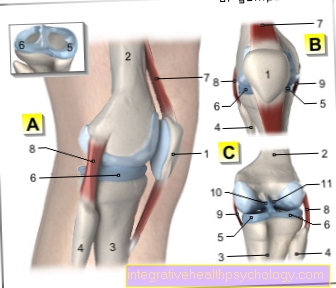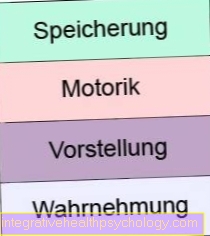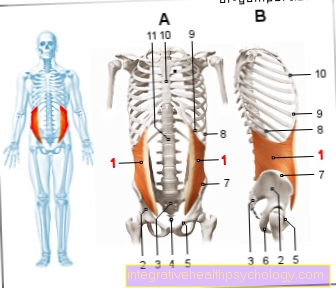Internal oblique muscle
Synonyms
Latin: M.. obliquus internus abdominis
- to overview abdominal muscles
- to the musculature overview
introduction
The internal oblique abdominal muscle (Musculus obliquus internus abdominis) is a three-sided, approx. 1 cm thick abdominal muscle directly below the external oblique abdominal muscle. It is the smallest of the three lateral abdominal muscles.
Approach, origin, innervation
Approach: Ribs 9-12, linea alba
Origin:
- Superficial sheet of the lumbar back bandage (Thoracolumbar fascia)
- middle lip of the iliac crest (Linea intermedia cristae iliacae)
- lateral half of the inguinal ligament
Innervation: Nn. intercostal VIII-XII
Illustration of the internal oblique muscle

Internal oblique muscle
- Internal oblique muscle -
Obliquus muscle
internus abdominis - Iliac scoop -
Ala ossis ilii - Sacrum -
Sacrum - Tailbone -
Os coccygis - Pubic bone -
Pubis - Ischium -
Os ischii - Iliac crest -
Iliac crest - 9th rib - Costa IX
- Costal cartilage -
Cartilago costalis - Sternum - sternum
- First lumbar vertebra -
- Vertebra lumbalis I
You can find an overview of all Dr-Gumpert images at: medical illustrations
How is the muscle trained / contracted?
The contraction takes place in the same way as with the external oblique abdominal muscles, but only reversed.
The following exercises are therefore particularly suitable:
- Side push-ups
- Abdominal crunch
In abdominal crunch, the effect on the internal oblique muscle can be increased by turning the upper body to the side during the contraction.
You can find an overview of all relevant topics in the area of strength training in the overview of strength training
How is the straight abdominal muscle stretched?

If the upper body is tilted or turned to one side, the opposite side is stretched at the same time.
You can find detailed information at:
- Stretching
- stretching
function
With a unilateral contraction, the trunk is tilted to one side and rotated. It works with the outer oblique abdominal muscles on the opposite side. In addition, the internal oblique abdominal muscle (Musculus obliquus internus abdominis) fixes the trunk when lifting and carrying heavy loads.





























